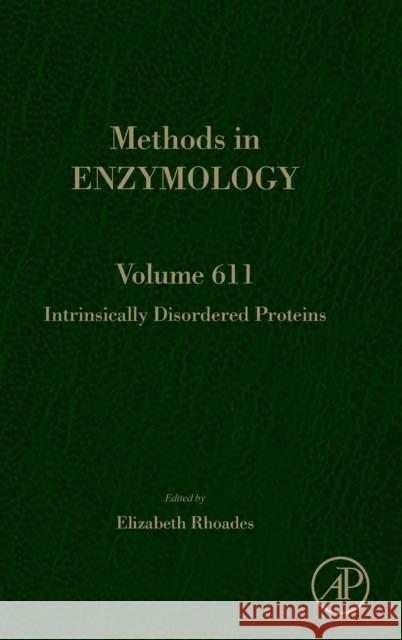Intrinsically Disordered Proteins: Volume 611 » książka



Intrinsically Disordered Proteins: Volume 611
ISBN-13: 9780128156490 / Angielski / Twarda / 2018 / 754 str.
Intrinsically Disordered Proteins: Volume 611
ISBN-13: 9780128156490 / Angielski / Twarda / 2018 / 754 str.
(netto: 659,43 VAT: 5%)
Najniższa cena z 30 dni: 691,03 zł
ok. 18-20 dni roboczych.
Darmowa dostawa!
1. Phase Separation of Intrinsically Disordered Proteins Ammon E. Posey, Alex S. Holehouse and Rohit V. Pappu 2. Methods and Strategies to Quantify Phase Separation of Disordered Proteins Alfredo Vidal Ceballos, Charles J. McDonald and Shana Elbaum-Garfinkle 3. Visualization and Quantitation of Phase-Separated Droplet Formation by Human HP1a Madeline M. Keenen, Adam G. Larson and Geeta J. Narlikar 4. Probing RNA Structure in Liquid-Liquid Phase Separation Using SHAPE-MaP Erin M. Langdon and Amy S. Gladfelter 5. The Use of 13C Direct-Detect NMR to Characterize Flexible and Disordered Proteins Erik C. Cook, Grace A. Usher and Scott A. Showalter 6. Using NMR Chemical Shifts to Determine Residue-Specific Secondary Structure Populations for Intrinsically Disordered Proteins Wade M. Borcherds and Gary W. Daughdrill 7. Experimental Characterization of Fuzzy Protein Assemblies: Interactions of Paramyxoviral NTAIL Domains With Their Functional Partners Francesca Troilo, Christophe Bignon, Stefano Gianni, Monika Fuxreiter and Sonia Longhi 8. Characterization of Dynamic IDP Complexes by NMR Spectroscopy Andreas Prestel, Katrine Bugge, Lasse Staby, Ruth Hendus-Altenburger and Birthe B. Kragelund 9. Spectroscopic Characterization of Structure-Function Relationships in the Intrinsically Disordered Protein Complexin David Snead and David Eliezer 10. Distances, Distance Distributions, and Ensembles of Unfolded and Intrinsically Disordered Proteins From Single-Molecule FRET Erik D. Holmstrom, Andrea Holla, Wenwei Zheng, Daniel Nettles, Robert B. Best and Benjamin Schuler 11. Probing Differential Binding Mechanisms of Phenylalanine-Glycine-Rich Nucleoporins by Single-Molecule FRET Piau Siong Tan and Edward A. Lemke 12. Fluorescence Depolarization Kinetics to Study the Conformational Preference, Structural Plasticity, Binding, and Assembly of Intrinsically Disordered Proteins Anupa Majumdar and Samrat Mukhopadhyay 13. Building, Characterization, and Applications of Cuvette-FCS in Denaturant-Induced Expansion of Globular and Disordered Proteins Timir Baran Sil, Bankanidhi Sahoo and Kanchan Garai 14. Stopped-Flow Kinetic Techniques for Studying Binding Reactions of Intrinsically Disordered Proteins Michael D. Crabtree and Sarah L. Shammas 15. The Use of Mass Spectrometry to Examine IDPs: Unique Insights and Caveats Dale Stuchfield, Aidan France, Lukasz G. Migas, Anja Thalhammer, Anne Bremer, Bruno Bellina and Perdita E. Barran 16. Characterizing Time-of-Day Conformational Changes in the Intrinsically Disordered Proteins of the Circadian Clock Jacqueline F. Pelham, Alexander E. Mosier and Jennifer M. Hurley 17. Assessing Allostery in Intrinsically Disordered Proteins With Ensemble Allosteric Model Jing Li and Vincent J. Hilser 18. A Tethered Vesicle Assay for High-Throughput Quantification of Membrane Fission Wilton T. Snead and Jeanne C. Stachowiak 19. Generating Novel Materials Using the Intrinsically Disordered Protein Ubx Gabriela Geraldo Mendes, Rebecca M. Booth, Donna L. Pattison, Adrian J. Alvarez and Sarah E. Bondos 20. Challenges in the Structural-Functional Characterization of Multidomain, Partially Disordered Proteins CBP and p300: Preparing Native Proteins and Developing Nanobody Tools Angela Bekesi, Sara Abdellaoui, Natalie Holroyd, Wouter Van Delm, Els Pardon, Jarne Pauwels, Kris Gevaert, Jan Steyaert, Stefaan Derveaux, Antoni Borysik and Peter Tompa 21. Characterization of the Binding of Small Molecules to Intrinsically Disordered Proteins Veselin S. Dobrev, Lisette M. Fred, Kaitlyn P. Gerhart and Steven J. Metallo 22. Targeting the Intrinsically Disordered Proteome Using Small Molecule Ligands Slawomir Wójcik, Melissa Birol, Elizabeth Rhoades, Andrew D. Miranker and Zachary A. Levine
Elizabeth Rhoades was born and raised in Huntsville, Alabama. As a child, she loved reading and when she left for college, she intended to major in English at Duke University. After taking a Physics course to fulfill a distribution requirement during her first year, she switched gears and decided to pursue a Physics major. In between her junior and senior years, she spent a summer at the University of Tennessee in a REU program, where she discovered biophysics. Liz earned her Ph.D. in 2001 from the Biophysics Research Division at the University of Michigan, working with Ari Gafni, a biophysical chemist, and Ducan Steel, a physicist, on understanding amyloid aggregation. It was in the Gafni-Steel lab that she became interested in understanding the physico-chemical basis of protein structure and dynamics and the power of fluorescence spectroscopy as a tool. She spent 2.5 years as a postdoctoral fellow with Gilad Haran at the Weizmann Institute, applying single molecule fluorescence to the study of protein folding, and then an additional 2.5 years as a postdoc in Watt Webb's lab at Cornell University. In 2006, Liz joined the faculty in the Molecular Biophysics & Biochemistry Department at Yale University, where she rose through the academic ranks. She moved to the Chemistry Department at the University of Pennsylvania in 2016. In her independent career, her research focuses on understanding both functional and dysfunctional aspects of intrinsically disordered proteins, with a focus on several implicated in neurodegeneration. She has served as chair of the Intrinsically Disordered Protein Subgroup of the Biophysical Society and currently serves as Associate Editor of the Proteins section of the Biophysical Journal. Her husband is also a scientist/professor and she has two young sons who plan to be superheroes when they grow up.
1997-2025 DolnySlask.com Agencja Internetowa
KrainaKsiazek.PL - Księgarnia Internetowa









